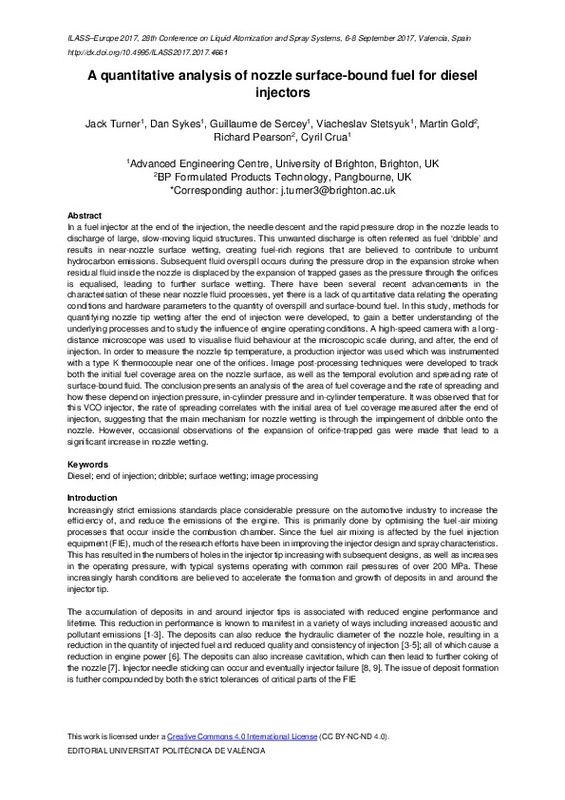JavaScript is disabled for your browser. Some features of this site may not work without it.
Buscar en RiuNet
Listar
Mi cuenta
Estadísticas
Ayuda RiuNet
Admin. UPV
A quantitative analysis of nozzle surface bound fuel for diesel injectors
Mostrar el registro sencillo del ítem
Ficheros en el ítem
| dc.contributor.author | Turner, Jack
|
es_ES |
| dc.contributor.author | Sykes, Dan
|
es_ES |
| dc.contributor.author | De Sercey, Guillaume
|
es_ES |
| dc.contributor.author | Stetsyuk, Viacheslav
|
es_ES |
| dc.contributor.author | Gold, Martin
|
es_ES |
| dc.contributor.author | Pearson, Richard
|
es_ES |
| dc.contributor.author | Crua, Cyril
|
es_ES |
| dc.date.accessioned | 2018-04-11T09:26:24Z | |
| dc.date.available | 2018-04-11T09:26:24Z | |
| dc.date.issued | 2017-07-28 | |
| dc.identifier.isbn | 9788490485804 | |
| dc.identifier.uri | http://hdl.handle.net/10251/100173 | |
| dc.description.abstract | [EN] In a fuel injector at the end of the injection, the needle descent and the rapid pressure drop in the nozzle leads to discharge of large, slow-moving liquid structures. This unwanted discharge is often referred as fuel ‘dribble’ and results in near-nozzle surface wetting, creating fuel-rich regions that are believed to contribute to unburnt hydrocarbon emissions. Subsequent fluid overspill occurs during the pressure drop in the expansion stroke when residual fluid inside the nozzle is displaced by the expansion of trapped gases as the pressure through the orifices is equalised, leading to further surface wetting. There have been several recent advancements in the characterisation of these near nozzle fluid processes, yet there is a lack of quantitative data relating the operating conditions and hardware parameters to the quantity of overspill and surface-bound fuel. In this study, methods for quantifying nozzle tip wetting after the end of injection were developed, to gain a better understanding of the underlying processes and to study the influence of engine operating conditions. A high-speed camera with a longdistance microscope was used to visualise fluid behaviour at the microscopic scale during, and after, the end of injection. In order to measure the nozzle tip temperature, a production injector was used which was instrumented with a type K thermocouple near one of the orifices. Image post-processing techniques were developed to track both the initial fuel coverage area on the nozzle surface, as well as the temporal evolution and spreading rate of surface-bound fluid. The conclusion presents an analysis of the area of fuel coverage and the rate of spreading and how these depend on injection pressure, in-cylinder pressure and in-cylinder temperature. It was observed that for this VCO injector, the rate of spreading correlates with the initial area of fuel coverage measured after the end of injection, suggesting that the main mechanism for nozzle wetting is through the impingement of dribble onto the nozzle. However, occasional observations of the expansion of orifice-trapped gas were made that lead to a significant increase in nozzle wetting. | es_ES |
| dc.description.sponsorship | This work was supported by BP Formulated Products Technology and the UK’s Engineering and Physical Science Research Council [EPSRC grant EP/K020528/1 and EP/N509607/1]. | es_ES |
| dc.format.extent | 9 | es_ES |
| dc.language | Inglés | es_ES |
| dc.publisher | Editorial Universitat Politècnica de València | es_ES |
| dc.relation.ispartof | Ilass Europe. 28th european conference on Liquid Atomization and Spray Systems | es_ES |
| dc.rights | Reconocimiento - No comercial - Sin obra derivada (by-nc-nd) | es_ES |
| dc.subject | Diesel | es_ES |
| dc.subject | End of injection | es_ES |
| dc.subject | Dribble | es_ES |
| dc.subject | Surface wetting | es_ES |
| dc.subject | Image processing | es_ES |
| dc.title | A quantitative analysis of nozzle surface bound fuel for diesel injectors | es_ES |
| dc.type | Capítulo de libro | es_ES |
| dc.type | Comunicación en congreso | es_ES |
| dc.identifier.doi | 10.4995/ILASS2017.2017.4661 | |
| dc.relation.projectID | info:eu-repo/grantAgreement/UKRI//EP%2FK020528%2F1/GB/Investigation of Non-Spherical Droplets in High-Pressure Fuel Sprays/ | es_ES |
| dc.relation.projectID | info:eu-repo/grantAgreement/UKRI//EP%2FN509607%2F1/GB/DTP 2016-2017 University of Brighton/ | es_ES |
| dc.rights.accessRights | Abierto | es_ES |
| dc.description.bibliographicCitation | Turner, J.; Sykes, D.; De Sercey, G.; Stetsyuk, V.; Gold, M.; Pearson, R.; Crua, C. (2017). A quantitative analysis of nozzle surface bound fuel for diesel injectors. En Ilass Europe. 28th european conference on Liquid Atomization and Spray Systems. Editorial Universitat Politècnica de València. 763-771. https://doi.org/10.4995/ILASS2017.2017.4661 | es_ES |
| dc.description.accrualMethod | OCS | es_ES |
| dc.relation.conferencename | ILASS2017 - 28th European Conference on Liquid Atomization and Spray Systems | es_ES |
| dc.relation.conferencedate | September 06-08,2017 | es_ES |
| dc.relation.conferenceplace | Valencia, Spain | es_ES |
| dc.relation.publisherversion | http://ocs.editorial.upv.es/index.php/ILASS/ILASS2017/paper/view/4661 | es_ES |
| dc.description.upvformatpinicio | 763 | es_ES |
| dc.description.upvformatpfin | 771 | es_ES |
| dc.type.version | info:eu-repo/semantics/publishedVersion | es_ES |
| dc.relation.pasarela | OCS\4661 | es_ES |
| dc.contributor.funder | BP, Reino Unido | |
| dc.contributor.funder | UK Research and Innovation | es_ES |
| dc.contributor.funder | Engineering and Physical Sciences Research Council, Reino Unido |








